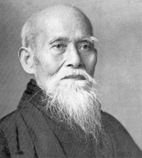What is Aikido?
The martial art of aikido has in recent years achieved wide recognition both in Japan, its birthplace, and abroad. This is a natural result of a steady growth of the art over the past forty years and, more recently, its portrayal in Hollywood films, seen by literally hundreds of millions of people. Although correctly identified as a martial art, aikido is apt to be lumped together in the public's consciousness with other well-known fighting arts such as judo, karate, kung fu, and taekwondo.
How does aikido differ from these other martial systems? Apart from clear-cut differences in technique, aikido is unique in that it is solely an art of self-defense. Aikido entirely lacks attacking movements, a phenomenon which reflects its philosophical and ethical principles. Other martial art systems possess both offensive and defensive techniques, and many of them have come to stress the sporting aspect. This is the case, for example, with judo, an Olympic sport since 1964, karate, and taekwondo, as well as various other arts. For many practitioners of these martial forms, participation and victory in competitions are more important than learning techniques for self-defense.
 O-Sensei Morihei Ueshiba O-Sensei Morihei Ueshiba
The emphasis in aikido is on the spiritual growth of the individual through the acquisition of defensive skills. The ethical dimension of aikido permeates every aspect of its practice both on and off the training mat. In the philosophy of aikido's founder, Morihei Ueshiba, aikido is a means for uniting people into a "one world family." It is not means for hurting others, but is rather a way of "loving self-protection."
Since its goal is distinct from other combative arts, it would be incorrect to assume that aikido practice is not vigorous or that its techniques are ineffective. Practiced in the traditional manner as taught by its founder, Morihei Ueshiba, aikido retains a strong martial edge. Techniques are executed firmly, but without violent intent. Powerful joint-locks and pinning movements control and immobilize adversary without causing crippling injury. Aikido techniques are indeed capable of causing serious bodily damage or even death. However, the principles of aikido proscribe such destructive behaviour.
|